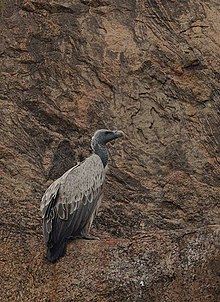Indian vulture
| Indian Vulture | |
|---|---|

| |
| Indian vulture | |
| Scientific classification | |
| Kingdom: | |
| Phylum: | |
| Class: | |
| Order: | Falconiformes (or Accipitriformes, q.v.)
|
| Family: | |
| Genus: | |
| Species: | G. indicus
|
| Binomial name | |
| Gyps indicus (Scopoli, 1786)
| |
| Synonyms | |
|
Gyps indicus indicus | |
The Indian Vulture (Gyps indicus) is an Old World vulture and is closely related to the Griffon Vulture, G. fulvus. It breeds mainly on crags in the hills of Sindh in Pakistan, central and peninsular Republic of India. The birds in the northern part of its range once considered a subspecies are now considered a separate species, the Slender-billed Vulture Gyps tenuirostris. These were lumped together under the name Long-billed Vulture.
The species breeds mainly on cliffs, but is known to use trees to nest in Rajasthan. Like other vultures it is a scavenger, feeding mostly from carcasses of dead animals which it finds by soaring over savannah and around human habitation. They often move in flocks.
The Long-billed Vulture is a typical vulture, with a bald head, very broad wings and short tail feathers. It is smaller and less heavily-built than the Eurasian Griffon, usually weighing between 5.5 and 6.3 kg (12–13.9 lbs) and measuring 80–100 cm (32-40 in) long and 205 to 229 cm (81–91 in) across the wings.[1] It is distinguished from that species by its less buff body and wing coverts. It also lacks the whitish median covert bar shown by Griffon.
Population declines

The Indian Vulture and the Indian White-rumped Vulture, G. bengalensis species have suffered a 99%–97% population decrease in Pakistan and India. The cause of this has been identified as poisoning caused by the veterinary drug diclofenac. Diclofenac is a non-steroidal anti-inflammatory drug (NSAID) and when given to working animals it can reduce joint pain and so keep them working for longer. The drug is believed to be swallowed by vultures with the flesh of dead cattle which were given diclofenac in the last days of life. Diclofenac causes kidney failure in several species of Vultures. In March 2005 the Indian Government announced its support for a ban on the veterinary use of diclofenac. Another NSAID, meloxicam, has been found to be harmless to vultures and should prove to be an acceptable substitute for diclofenac. In March 2006 diclofenac was still being used for animals throughout India and the changes in Indian legislation are awaited. When meloxicam production is increased it is hoped that it will be as cheap as diclofenac.
Captive-breeding programmes
Captive-breeding programmes for several species of Indian vulture have been started. The vultures are long lived and slow in breeding, so the programmes are expected to take decades. Vultures reach breeding age at about 5 years old. It is hoped that captive-bred birds will be released to the wild when the environment is clear of diclofenac.
References
- Template:IUCN2006 Database entry includes a range map and justification for why this species is critically endangered
External links
- Conserving Asia's critically endangered vultures
- Vulture Territory Facts and Characteristics: Long Billed Griffon
- BirdLife Species Factsheet.

